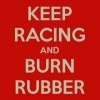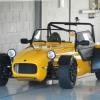Hi, Again,
The 0.5 metre test is a very repeatable test because, as long as you have 3m clear around you, reflection from objects is ruled out. I once tested a Metro 6R4 in a garage courtyard before a rally.Once at the venue, the 0.5 metre test was repeated and yielded identical results. You are also testing to a level way above the ambient noise level (typically 50-70dB(A)) so that also has a negligible effect when testing to 100dB(A).
The ground surface can introduce more variables, however. I assisted at a rally last weekend and we were testing on wartime, tamped concrete. The Senior Official (who has carried out tests there at many events said that we were to test to a limit of 102dB(A) as, from his experience of that venue, he has to make that adjustment. The testing on the day found that to work with a good few of the front running cars reading between 100-102, rather than the usual 98-100. We sent four cars (from 67) away to check over their exhausts befre resubmitting. My feeling is that it may be due to the corrugations, Mike thinks it may be something to do with vibrations in the slabs of concrete. Though an Environmental Scrutineer will have a calibrated meter, and will perform calibration checks during the period of a test, local variations will not be ignored and if I were to start a test and the first few cars were all to fail, I would very much be looking at my equipment / procedures rather than send every competitor away. If the odd cars fail, I tell the drivers that "Exhausts are not like dogs, they are just for Christmas" that can, and do, wear out, or become damaged - or even show the signs of a badly adjusted / about to fail engine.
I am old enough to have suffered the large radius tests, and was threatened with exclusion when my standard (engine and exhaust) BMW 2002Tii recorded a higher reading than the MG Metro 6R4 in the queue before me! There were gusty winds pushing sound towards the meter and guess who was tested during a gust?
Particularly with rear engined cars, I see various techniques employed by drivers to quieten down their cars at sound tests. Some hold the clutch down, some will hold the car on the handbrake and bring the clutch up almost to biting point. These are all possible if people have found them to work. One technique we don't like is people who have switches to alter the reading of their rev counters. Once you have done a few tests on a morning, you get used to the amount of mechanical mayhem for 4,500 rpm and can soon spot a cheating tacho. For those without rev counters, I normally take a Snap-On timing light to events and clipping that onto a plug lead gives me a number to work with.
I'm with Archibald Meatpants in that a standardish Zetec should not be problemattical.
One last point - it is possible to over pack a re-packable silencer. Follow your manufacturer's instructions and don't be tempted to use up the rest of the roll (or whatever) just because there appears to be room for it in the can!
Simon



